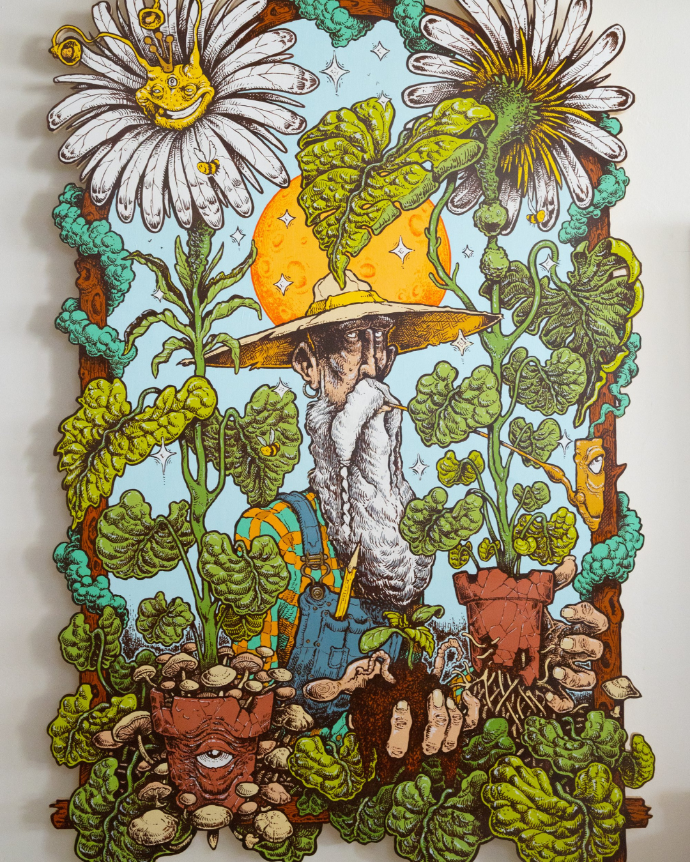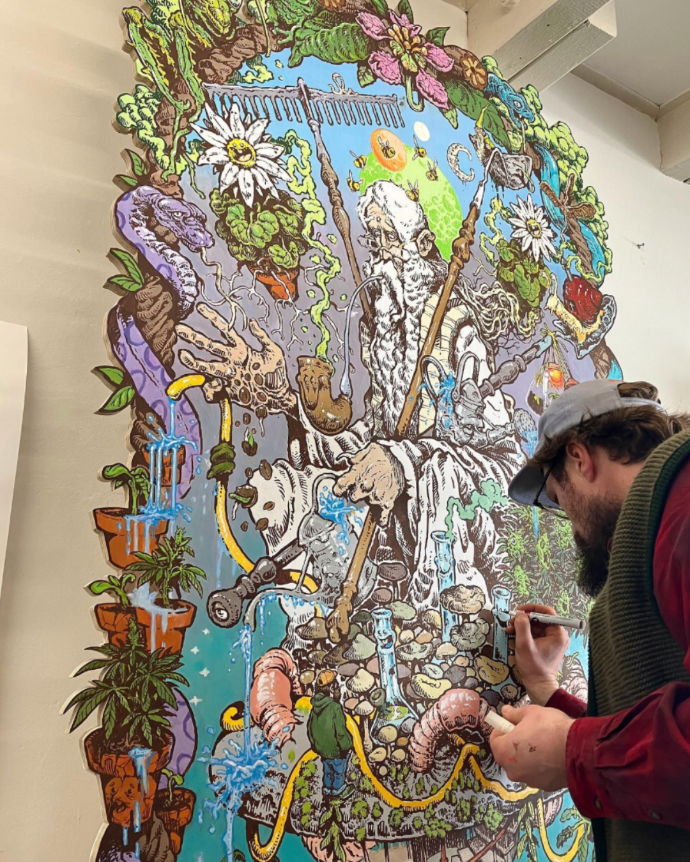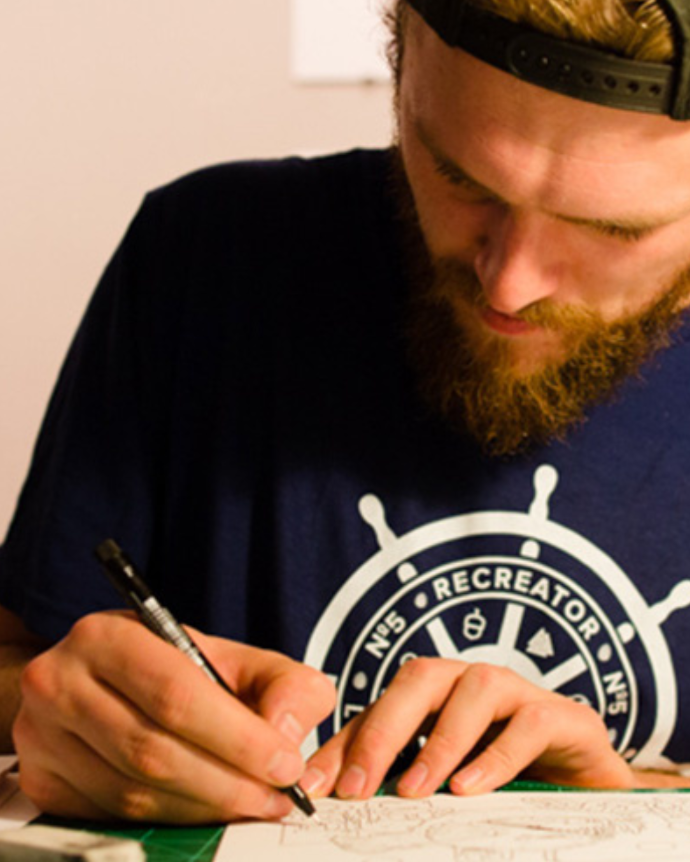In the universe of psychedelic art and cannabis culture, Mossy Giant emerges as an iconic and multifaceted figure. His work, an amalgam of hippies, bears, mushrooms, and plants, is a vibrant celebration of nature and spirituality.
Mossy, a passionate advocate for living in harmony with the Earth, uses his art to convey a message of love, ecology, and a utopian existence. His artistic and personal journey is deeply intertwined with cannabis, hippie culture, and an unwavering commitment to sustainability.
Your art is a vibrant mix of hippies, bears, mushrooms, and plants. What inspires you to combine these elements in your illustrations?
"When I draw things like this, such themes, it makes me happy, and that's the first motivation. The first time I drew the hippie, for example, many years ago, as soon as I drew this character, I said, 'Wow, this does something to me on a deeper level.'
I enjoy drawing this guy with the beard, it's like a wise man, and in a way, I see myself in him, it's a reflection of me. And so, when I drew the hippie, I realized he needed a companion, a friend, and I drew him in the car, and in the back of the car, there was nothing. What can I put in the back of the car? I thought about it one night, and there was the bear.
So I put the bear in the back of the car and said, 'Oh my God, this is what I want to draw.' And I get a sense of enjoyment every time I draw these two characters. Sometimes they disappear, but they always come back, and there are always certain points in the year when I'm bored with work, and that's when I draw the hippie and the bear, and something good always comes out of it.

And of course, the natural world. My artistic themes are a lot about growing plants, living in harmony with mother nature, treating the soil the right way and, ultimately, it's like a utopian world where humanity lives in perfect harmony with nature. I hope that expresses my work.
I'm not a farmer, I'm not a worker. I guess, in a way, I'm a hippie. Sometimes I wish I had been born in the 60s and 70s. That era for me is very interesting simply because people were rejecting normal life and governments and power structures. And then came the summer of love, people were experimenting with all kinds of mind-expanding compounds, like mushrooms, acid, and cannabis. It was a very creative time, a very vibrant time.
For me, it was too, which is why in what I draw I also try to live it. I'm always preaching about cannabis, preaching about treating the soil the right way, and I think ultimately, if we live in balance and treat the soil and the plants and the animal kingdom the right way, the planet will automatically flourish and become healthy."
Have you always made art with this theme, or did it come later? And if so, what led you to make that decision?
"Well, in a way, I already answered this, didn't I? But if you want to add something more, art has been part of my life, all my life. My mother is an artist, and she always encouraged me and my brother to be creative. So when we were drawing, my mom really enjoyed it.
When I was about 12 years old, I did my education in the United States, where I studied graphic design. The hippie and the bear emerged right after college. I studied graphic design and then became freelance as an artist, I started working more with images, and because of that, I got interest from the cannabis industry. I became very good friends with Albert, Soma's right-hand man, and he asked me to rebrand the Soma brand."
Cannabis plays a central role in your life and work. How does cannabis use influence your creative process and the themes of your works?
“Cannabis is a fundamental part of my creative process. When I need to create new ideas, especially in the sketching phase, I like to consume cannabis because it helps me find connections faster and solve problems more easily.
In the execution phase, when the work becomes more technical, I tend to consume cannabis at night, after my kids are in bed and all tasks are done. My wife and I sit on the couch to discuss the day. It really helps me. It helps me relax and reflect on the day.
Mainly, I am a night smoker, at the end of the day, to reduce stress. I don't think cannabis is a depressant as many say; it depends on the strain, it can be relaxing or energizing. Cannabis works for me in both ways, relaxing, energizing, and right in the middle."
In your illustrations, we see a strong presence of hippie culture. What attracts you to this subculture and how do you think it relates to your art and message?

"The hippies were right. The bottom line is love and caring for each other, taking care of the planet, building small communities. That was overcome by the American governments that were repressing the hippies because it was too free-thinking. Over time, we went in a different direction, we started going through an administrative system, then free trade and with it exponential growth and making money. Until now, on a planet where we have dying ecosystems and wars over resources and oil.
A very messed up place, in my opinion. If we exerted a bit of the hippie mindset in the world, I think this place would be much better. And that's why I express this hippie mindset through my art and try to inspire some people, that's why I enjoy drawing these themes, because I see and romanticize everything as an artist, I have to romanticize everything and show people the world in my illustrations.
For me, it's super positive, and I know that's utopian, it might not happen, but at least we can try to change people's minds. And I think cannabis and the hippie mindset are necessary in today's world for it to be a better place."
Your art has a clear connection with nature. What role do ecology and the environment play in your work and daily life?
"Ecology plays a major role in my work. I think it does for everyone, but some people are just not aware of it. We live on this planet and ultimately activists say we have to save the planet, we have to say no, we don't have to save the planet, we have to save humanity. The planet will be fine without us.
We are on a very destructive path with our planet today. But we have to understand the systems the world has provided, for example, the way soil and soil bacteria create life through composting. We just have to feed the soil with the right elements and grow organically instead of adding minerals and salts and more minerals and more salts and give the plant only what they need. We need to create a holistic environment for a plant to thrive.
If we do that, we create a holistic environment not just for plants, but for other aspects of our lives. All this can be done through plants, especially cannabis plants, treating the soil with love and care. I think the soil is the most important thing in our lives.
This planet thrives, and right now, the way we consume, the way we grow our food, and how we grow our medicine, is not right. I just finished a piece called 'Living Soil,' which is a new print coming out, I think, at the end of November, which basically shows the farmer and then you can see all the stages of the cannabis plant. From a seed, a seedling, the vegetative state to the fully harvestable plant. Around the plants, there are then worms and also mushrooms, fungi and life is being created. It's all very nerdy in a sense."
We have seen you participate in various collaborations and community projects. Could you tell us about a recent collaboration that has been significant for you?
"In the last two years, I have been working on a standout project. It's a collaboration with a social club in Barcelona called Lecann Garcia, and the owner, Stefan, is a good friend I've known for 10 years. Stefan asked me to portray the history of cannabis for his club. It was a dream job for me and I said, 'okay, let's do it.' It has taken us time until now, having finished a large piece that spans the history of cannabis.
Last year, we really focused on Dutch culture and creating a book and a piece of art that portrays the history of Dutch cannabis from around 1960 to the 2000s and all the people and pioneers involved. People who risked their lives for these plants and through this project, I have come to know many very interesting people, the pioneers who have been part of this history and people in the industry in general. So, for me, that's the biggest project I'm involved in right now.
I recently did a collaboration with a French grower, Monster Grower, La Chambria, who is a French guy living with his family on a farm. A closed-loop farm where everything is reused. We talked about what I represent as an artist. He is a grower, he manages his soil, he is a true plant man, has green hands and allowed me to make the best art for him. This art is used in a product, in a crop where the extracts have been grown the right way.
So the great history of cannabis, the collaboration with La Chambria, and many more, allow me to live as an artist thanks to this plant and the people who believe in my work. So when Stefan asked me to do the grand history of cannabis, it really is something I would do in my spare time anyway."
What role do you think art plays in the normalization of cannabis and in the fight against the stigma associated with its use?
"I think art plays a very big role in this, and I'll explain exactly how it works. With the project 'The Grand History of Cannabis,' we talk about the history of this plant, which is very turbulent, and people put their lives at risk, and sometimes the topics are very delicate.
Since the plant is so stigmatized, even here in the Netherlands, people say 'oh no, marijuana is a drug, it's bad, it's scary,' and 'oh no, I've never smoked marijuana.' It's very, very stigmatized. And what art does and what my project 'The Grand History' does is that everyone can observe this piece of art, whether you're a smoker or not, whether you like cannabis or hate it, you can observe the art and appreciate it. You say, 'oh wow, this is cool, there's so much to see, what fun characters.' But then, when you look more and spend time observing the piece of art, you might wonder 'who is this person? Why is this woman portrayed?' And so the conversation begins.
What art does is create a very low barrier to start a conversation that would otherwise be very difficult to engage in. If I come up to you and say, 'you have to read this book and know this, this, and this,' but if I say, 'hey, I have a cool piece of art, let's look at it,' you say, 'yeah, sure, let's look at it.' And then there might be characters there that spark a question in your mind, like 'who is this person? What does this mean?' Well, this person did this for the plant, or this is Mila, the Hash Queen, and you can talk about Mila, she has done amazing things. Or even Ben Dronkers, 'who is this guy?' Sensi Seeds, one of the largest companies in the Netherlands, creates products from industrial hemp. So, you can go on and on. Even portraits of politicians, 'why do these politicians have devil horns and why are they dark?' Well, they made unjust laws and have helped stigmatize this plant.
Therefore, art is really a way to start a conversation, to steer the conversation in the right direction, and not to talk down to people. Art is accessible to everyone because it's universal. And you don't have to make people read 300 pages. Sure, you want people to read, but first, you have to spark their imagination, spark their curiosity, and through this piece of art, or through art in general, it can happen that they then read more. So that's my role in helping to destigmatize this cannabis plant with my art. I hope that makes sense."
Lastly, what advice would you give to young artists who want to incorporate controversial topics like cannabis into their work? What should they keep in mind to be authentic and effective in their message?
"You have to believe in what you're drawing or doing, and in the topics you're portraying in your work. As I completely believe in the potential of cannabis, that it can help us in all aspects of our life, for everyone, globally. I believe in that, in the core of my soul, the core of my body, and that's what I put on paper. And if you don't have that, you better not even start because, as I said, it won't be authentic. And I think if you stay authentic, if you stay true to yourself, then the topic you put on paper will resonate with other people who feel the same way you do. You have to be willing to put in the time, because it takes a long time to succeed in art, it's hard.

They always say that after 10 years of doing something, after 10 years you start to see results, and it's absolutely true. Years ago, when I was just starting and reading about this kind of thing, I would say 'yeah, you need at least 10 years,' and I thought 'no, that's not true, I can do it in three.' No, 10 years is a turning point and I've noticed that. After 10 years, things really started to work. So it's about having patience, it's about creating a life for yourself that allows you to be free as an artist.
At first, when I was younger, now I'm 36, when I started I was 22, I made sure my life was easy, I didn't have big bills, I didn't have kids, no responsibilities. It's important for an artist to have mental space to be creative, to experiment, and find their voice. Because I didn't start by saying 'I'm a cannabis artist and I want to do this about living soil.' No, I learned about this and incorporated it into my work and found my interest and it was something worth expressing for me. I think in 10 years, looking back at this conversation, I hope I have changed again and have another conversation. In 10 years, maybe cannabis will be legal worldwide and we have contributed enough. I don't know. There's money to be made, and sure, we all have to make a living, we all need something to eat, but we have to do it together. And fortunately, I meet a lot of hippies in this industry, which I enjoy, modern hippies, psychedelic hillbillies. Authenticity and passion are essential for your work to resonate with others."